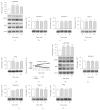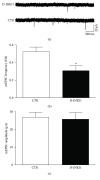Evidence of Presynaptic Localization and Function of the c-Jun N-Terminal Kinase
- PMID: 28367336
- PMCID: PMC5359460
- DOI: 10.1155/2017/6468356
Evidence of Presynaptic Localization and Function of the c-Jun N-Terminal Kinase
Abstract
The c-Jun N-terminal kinase (JNK) is part of a stress signalling pathway strongly activated by NMDA-stimulation and involved in synaptic plasticity. Many studies have been focused on the post-synaptic mechanism of JNK action, and less is known about JNK presynaptic localization and its physiological role at this site. Here we examined whether JNK is present at the presynaptic site and its activity after presynaptic NMDA receptors stimulation. By using N-SIM Structured Super Resolution Microscopy as well as biochemical approaches, we demonstrated that presynaptic fractions contained significant amount of JNK protein and its activated form. By means of modelling design, we found that JNK, via the JBD domain, acts as a physiological effector on T-SNARE proteins; then using biochemical approaches we demonstrated the interaction between Syntaxin-1-JNK, Syntaxin-2-JNK, and Snap25-JNK. In addition, taking advance of the specific JNK inhibitor peptide, D-JNKI1, we defined JNK action on the SNARE complex formation. Finally, electrophysiological recordings confirmed the role of JNK in the presynaptic modulation of vesicle release. These data suggest that JNK-dependent phosphorylation of T-SNARE proteins may have an important functional role in synaptic plasticity.
Conflict of interest statement
There is no actual or potential conflict of interests.
Figures







Similar articles
-
Presynaptic c-Jun N-terminal Kinase 2 regulates NMDA receptor-dependent glutamate release.Sci Rep. 2015 Mar 12;5:9035. doi: 10.1038/srep09035. Sci Rep. 2015. PMID: 25762148 Free PMC article.
-
Taurine potentiates presynaptic NMDA receptors in hippocampal Schaffer collateral axons.Eur J Neurosci. 2006 Jul;24(2):405-18. doi: 10.1111/j.1460-9568.2006.04911.x. Epub 2006 Jul 12. Eur J Neurosci. 2006. PMID: 16836643
-
N-methyl-D-aspartate autoreceptors respond to low and high agonist concentrations by facilitating, respectively, exocytosis and carrier-mediated release of glutamate in rat hippocampus.J Neurosci Res. 2007 Dec;85(16):3657-65. doi: 10.1002/jnr.21446. J Neurosci Res. 2007. PMID: 17671992
-
Functional interactions between presynaptic NMDA receptors and metabotropic glutamate receptors co-expressed on rat and human noradrenergic terminals.Br J Pharmacol. 2007 Aug;151(7):1087-94. doi: 10.1038/sj.bjp.0707280. Epub 2007 Jun 25. Br J Pharmacol. 2007. PMID: 17592518 Free PMC article.
-
Dopamine D(1) and D(3) receptors oppositely regulate NMDA- and cocaine-induced MAPK signaling via NMDA receptor phosphorylation.J Neurochem. 2007 Oct;103(2):840-8. doi: 10.1111/j.1471-4159.2007.04840.x. J Neurochem. 2007. PMID: 17897358
Cited by
-
Synaptic alterations as a common phase in neurological and neurodevelopmental diseases: JNK is a key mediator in synaptic changes.Neural Regen Res. 2023 Mar;18(3):531-532. doi: 10.4103/1673-5374.346488. Neural Regen Res. 2023. PMID: 36018163 Free PMC article. No abstract available.
-
Paeoniflorin ameliorates cognitive impairment in Parkinson's disease via JNK/p53 signaling.Metab Brain Dis. 2022 Apr;37(4):1057-1070. doi: 10.1007/s11011-022-00937-2. Epub 2022 Mar 1. Metab Brain Dis. 2022. PMID: 35230626 Free PMC article.
-
Cytoskeleton and Associated Proteins: Pleiotropic JNK Substrates and Regulators.Int J Mol Sci. 2021 Aug 4;22(16):8375. doi: 10.3390/ijms22168375. Int J Mol Sci. 2021. PMID: 34445080 Free PMC article. Review.
-
The selective disruption of presynaptic JNK2/STX1a interaction reduces NMDA receptor-dependent glutamate release.Sci Rep. 2019 May 9;9(1):7146. doi: 10.1038/s41598-019-43709-2. Sci Rep. 2019. PMID: 31073146 Free PMC article.
-
Involvement of JNK1 in Neuronal Polarization During Brain Development.Cells. 2020 Aug 13;9(8):1897. doi: 10.3390/cells9081897. Cells. 2020. PMID: 32823764 Free PMC article. Review.
References
Publication types
MeSH terms
Substances
LinkOut - more resources
Full Text Sources
Other Literature Sources
Research Materials
Miscellaneous

